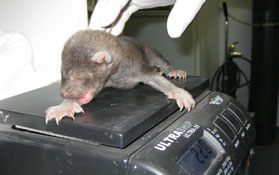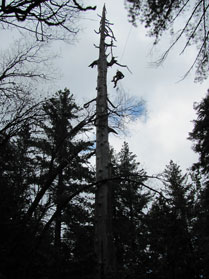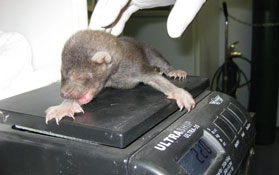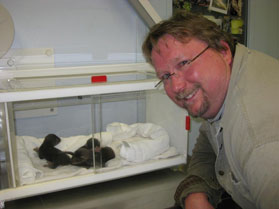UC researchers rescue five orphaned Pacific fisher kits
-
May 6, 2010
-
-
CONTACT: Jeannette Warnert
-
(559) 646-6074
-
jewarnert@ucdavis.edu
-
-
N / A
-
 See end of release for high-resolution photos.
See end of release for high-resolution photos.University of California wildlife biologists are seeking community involvement and support to care for five orphaned Pacific fishers they rescued in the Sierra Nevada near Bass Lake and Fish Camp last week. The kits are the offspring of two females that were part of an ongoing Pacific fisher research program. One of the females was killed by a bobcat; the other was hit by a car.
“We knew that the female fishers had kits, and that these animals are rare in California,” said Rick Sweitzer, UC Berkeley wildlife biologist and project leader. “We couldn’t in good conscience let the baby animals perish in their den cavities knowing we might be able to intervene.”
The two females – along with 28 other fishers – are being tracked daily by the Oakhurst-based research team, which is working to document the size of the fisher population and determine whether the population is in decline, stabilizing or growing. The seven-year study, which began in 2008, is part of the Sierra Nevada Adaptive Management Project (SNAMP).
The Pacific fisher is a small, nocturnal carnivore that perches and dens in large, old-growth pine and oak trees. Once widespread across the high elevation forests of the Sierra Nevada and in the coastal mountains of northwestern California, fishers are now only found in two small isolated populations. One group lives near the California-Oregon border. The orphaned animals are part of the southern Sierra Nevada population, estimated to be about 350 animals in all.
Data being collected by UC scientists about the movements, habitat preferences and survival of fishers in the southern Sierra Nevada will be used to aid the multiple agencies, academic institutions, environmental groups, and mountain residents who are working together to ensure that long-term wildland management promotes forest health, wildfire control and wildlife conservation.
The rescued fishers are now being cared for by veterinarian Lewis Wright at the Fresno Chaffee Zoo. Over the next three to five months they will be bottle fed, weaned to solid food, and then trained to hunt on their own in preparation for eventual release back into the wild, Sweitzer said.
“The SNAMP team will be working with the zoo, the Department of Fish and Game and other researchers to ensure the kits stay healthy and learn the skills they will need to survive in the wild,” he said.
Donations from the public are being sought to purchase milk replacement formula and supplies to build outdoor cages for the rescued fishers. To make contributions, contact Anne Lombardo of UC Cooperative Extension at amlombardo@ucdavis.edu, (559) 676-0576.
The researchers are also seeking community input for the baby fishers’ names. Name suggestions are being collected from the students at Yosemite High School, the North Fork Rancheria of Mono Indians and the staff at the Forest Service Bass Lake Ranger District Office.
“Although scientists normally avoid naming individual animals they are studying, in this case we hope to establish a connection and engender support in the local community for the orphaned fishers,” Sweitzer said. “I see this as a unique opportunity for local residents in the area to learn more about an interesting animal that very few people will ever get the chance to see.”
* * *
Last week’s fisher orphan rescues were a departure from the researchers’ routine aerial and ground tracking program. Typically, the crew captures fishers in humane traps and attaches radio collars, then plots the animals’ daily movements. When one stops moving entirely – presumably because it died – they track down the animal to determine what happened.
The morning of April 28, aerial monitoring determined that a female fisher had been inactive for at least 12 hours. On the ground, the crew found the carcass of the fisher and bobcat tracks in the snow.
“It’s a very sad, sinking feeling when you know that a female fisher with kits in a den has been killed,” Sweitzer said. “The first thought that comes to mind is whether the kits are OK and whether you can save them.”
The team organized their climbing gear and set out at 5:00 the following morning to rescue the kits.
“When our climber reached the top of the suspected den tree, he could hear the kits crying inside,” Sweitzer said. “That was our first indication that the animals were still alive. We were all very excited to know that the kits had survived overnight and that we might actually be able to save them. We found three kits in the tree, lowered them to the ground and rushed them down from the mountains. All three are alive and doing well at the zoo right now.”
On Sunday morning, May 2, a fisher team member was driving north on Highway 41 on the way to track other fishers to their den trees when she saw a dead female fisher on the road.
“Her body was still warm. She had been hit within the hour,” Sweitzer said. “It’s one thing when one of the animals is killed by a predator. That’s a natural event. But when they get hit by cars, it is more difficult for us. You wish there was a way it could have been prevented.”
The researchers went back to their Oakhurst office, collected tree climbing gear and returned to the site of the accident. Two days before, they had determined that the fisher had moved her kits to a tree on the steep hillside about 350 meters above the highway.
The den was in an unstable, dead snag. It took the researchers 11 hours to set up rigging from two adjacent trees to traverse in mid air over to the snag, investigate the cavity and rescue the kits, which had apparently been sleeping peacefully through the day-long ordeal.
“As soon as we were able to lower the kits to the ground, we called the veterinarian in Fresno and he came in after hours to admit them into the zoo,” Sweitzer said.
For more information about the Sierra Nevada Adaptive Management Project, see its website at http://snamp.cnr.berkeley.edu.
Media contact:
Rick Sweitzer, (559) 642-4539, rasweitzer@berkeley.edu
 Click for high-resolution image.
Click for high-resolution image.UC research crew member Taylor Gorman uses tree climbing
equipment to reach orphan fishers in an unstable snag. Click for high resolution image.A fisher kit is weighed at the Fresno Chaffee Zoo.
Click for high resolution image.A fisher kit is weighed at the Fresno Chaffee Zoo.
 Click for high-resolution image.
Click for high-resolution image.UC wildlife biologist Rick Sweitzer with the five orphaned Pacific fisher.



